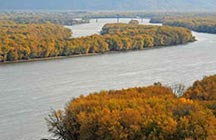 |
 |
|
| eNews • June 2014 | ||
| Promoting a Cost-Effective, Reliable and Competitive Transportation System |
||
 WRDA conference report advances.
WRDA conference report advances.
Both the House of Representatives and the Senate recently passed the Water Resources Development Act (WRDA) conference report. The conference report is currently waiting for President Obama’s signature. The House passed the legislation on May 20th by a vote of 412-4. The Senate approved the measure on May 22nd by a 91-7 majority.
The WRDA conference report is a good bill for those industries, like agriculture, that rely on the inland waterway system to remain competitive. Congressman Bill Shuster (R-PA), Chairman of the House Transportation and Infrastructure Committee, Senator Barbara Boxer (D-CA), Chairman of the Senate Environment and Public Works Committee, Congressman Nick Rahall (D-WV), Ranking Member of the House Transportation and Infrastructure Committee, Senator David Vitter (R-LA), Ranking Member of the Senate Environment and Public Works Committee, Congressman Bob Gibbs (R-OH), Chairman of the House Transportation and Infrastructure Subcommittee on Water Resources and the Environment, and Congressman Tim Bishop (D-NY), Ranking Member of the of the House Transportation and Infrastructure Subcommittee on Water Resources and the Environment should be commended for educating their membership on the need for WRDA and demonstrating the leadership required to produce legislation in a very contentious environment.
Since there has been a sizable number of new members of Congress - particularly in the House of Representatives - since the last WRDA bill was passed in 2007, there were many members of Congress who had never worked on a WRDA bill and who did not have a rudimentary understanding of the bill's importance. Congressional leadership - particularly Chairman Shuster, Ranking Member Rahall, Congressman Gibbs, and Congressman Bishop - worked diligently to educate their colleagues and the broader public of the need to pass a WRDA bill.
One of the most favorable components of the conference report is the likelihood for increased funding for harbor maintenance. The Harbor Maintenance Trust Fund (HMTF) was created by Congress in 1986 to provide funding for harbor and channel dredging. Funds generated by the Harbor Maintenance Tax (a 0.125% ad valorem tax on imports) are deposited into the HMTF. Heretofore, only half of the funds deposited into the HMTF are actually utilized for harbor and channel dredging. The rest has been repeatedly appropriated by Congress for other, unrelated expenditures.
The WRDA conference report increases each year the amount of funding generated by the Harbor Maintenance Tax for harbor maintenance activities. By the year 2025, 100% of the funds generated by the tax will be utilized for harbor maintenance and dredging. This will provide ports like the Mississippi Gulf port region (which accounts for 58% of soybean exports and 67% of corn exports) with necessary funds to ensure the shipping channel is adequately dredged. With the expansion of the Panama Canal scheduled to be completed in late 2015 to early 2016, it is imperative for U.S. port regions to be able to accommodate the larger ships that will be able to transit the larger canal. According to our research, the Panama Canal expansion will result in an additional 500,000 bushels of soybeans being loaded onto an ocean vessel. This is the equivalent of $6 million to $7 million of additional value per vessel. However, the Panama Canal expansion will be a missed opportunity for U.S. soybean shippers unless we are properly maintaining and improving our port regions. The likely additional funding from WRDA will help ensure this.
The WRDA conference report will direct the federal government to assume more responsibility for the over-budget Olmsted Lock and Dam project. The Olmsted Lock and Dam project (located on the Ohio River near the confluence with the Mississippi River) had an original cost estimate of $775 million. The most recent cost estimate is $3.1 billion - a 400% cost overrun.
Currently, funding for the Olmsted Lock and Dam is 50% funded via the Inland Waterways Tax (the $0.20 per gallon tax on diesel fuel paid by the barge companies) and 50% from the general treasury. Currently, approximately $160 million ($80 million paid by the barge companies; $80 million paid by the general treasury) is appropriated for the Olmsted Lock and Dam project on an annual basis. The WRDA conference report increases the federal government responsibility for funding Olmsted from 50% to 85% (approximately $80 million to $136 million each year). The barge company portion will decrease from 50% to 15% (from approximately $80 million to $24 million each year). This will free up approximately $56 million (heretofore being paid by the barge companies to Olmsted) per year to be utilized for other needed projects on the inland waterway system.
The WRDA conference report includes language directing the Army Corps of Engineers to streamline how it does business so that the planning, maintenance, and construction activities will hopefully become more expeditious.
The legislation directs the Corps to examine alternative financing approaches that may result in better project execution, including the use of bonding and public-private partnerships. The Soy Transportation Coalition recently released a soybean checkoff-funded study that examined the prospects for public-private partnerships on the inland waterway system: Click Here to view the study
Soy Transportation Coalition |
|
